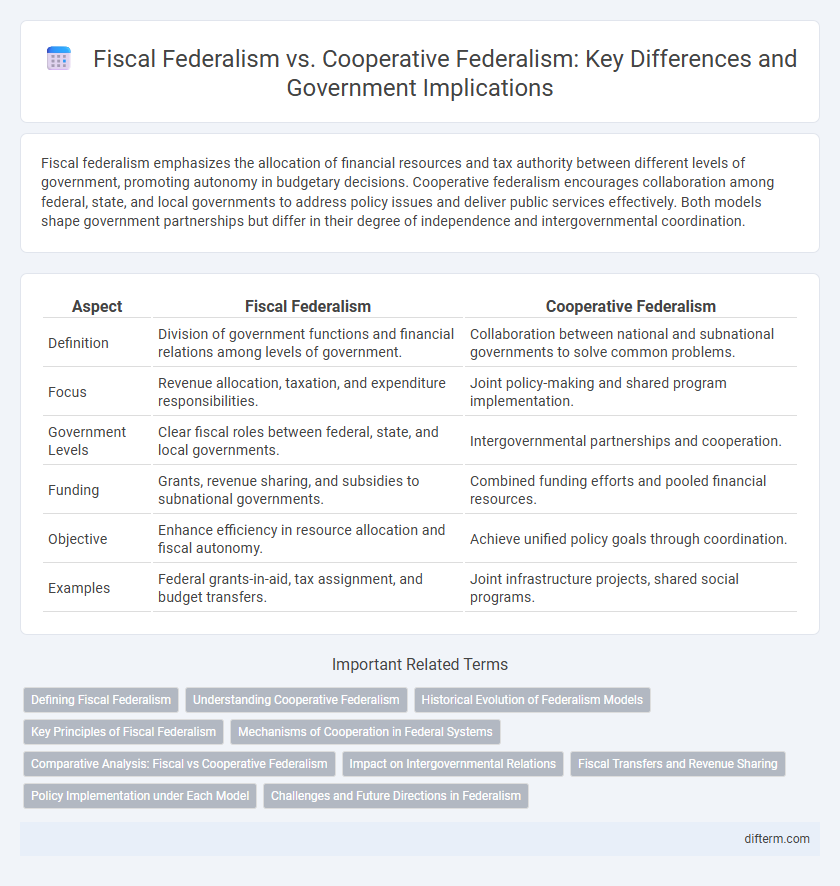Fiscal federalism emphasizes the allocation of financial resources and tax authority between different levels of government, promoting autonomy in budgetary decisions. Cooperative federalism encourages collaboration among federal, state, and local governments to address policy issues and deliver public services effectively. Both models shape government partnerships but differ in their degree of independence and intergovernmental coordination.
Table of Comparison
| Aspect | Fiscal Federalism | Cooperative Federalism |
|---|---|---|
| Definition | Division of government functions and financial relations among levels of government. | Collaboration between national and subnational governments to solve common problems. |
| Focus | Revenue allocation, taxation, and expenditure responsibilities. | Joint policy-making and shared program implementation. |
| Government Levels | Clear fiscal roles between federal, state, and local governments. | Intergovernmental partnerships and cooperation. |
| Funding | Grants, revenue sharing, and subsidies to subnational governments. | Combined funding efforts and pooled financial resources. |
| Objective | Enhance efficiency in resource allocation and fiscal autonomy. | Achieve unified policy goals through coordination. |
| Examples | Federal grants-in-aid, tax assignment, and budget transfers. | Joint infrastructure projects, shared social programs. |
Defining Fiscal Federalism
Fiscal Federalism defines the allocation of financial powers and responsibilities among different levels of government, typically federal, state, and local jurisdictions. It centers on how revenue sources, such as taxes and grants, are distributed to ensure efficient public service delivery and fiscal autonomy. Key components include intergovernmental transfers, expenditure assignments, and revenue-sharing mechanisms that balance local needs with national priorities.
Understanding Cooperative Federalism
Cooperative federalism emphasizes collaboration between national, state, and local governments to address complex policy issues through shared resources and jointly implemented programs. This model fosters intergovernmental partnerships, promoting efficiency and unified responses in areas such as education, healthcare, and infrastructure development. Understanding cooperative federalism highlights the dynamic interaction and mutual support mechanisms that strengthen governance and public service delivery across different government layers.
Historical Evolution of Federalism Models
Fiscal federalism emerged in the early 20th century, emphasizing the allocation of financial responsibilities and resources between national and subnational governments to promote efficiency and equity. Cooperative federalism arose during the New Deal era, highlighting collaboration and shared functions between different levels of government to address complex social and economic issues. The historical evolution reflects a shift from rigid fiscal boundaries toward integrated policy-making and joint governance.
Key Principles of Fiscal Federalism
Fiscal federalism centers on the allocation of taxing and spending powers among different levels of government to achieve economic efficiency and equity. It emphasizes the principles of vertical and horizontal fiscal imbalances, subsidiarity in public service delivery, and the use of intergovernmental transfers to correct fiscal disparities. Revenue autonomy and expenditure responsibilities are carefully balanced to ensure local governments have adequate resources without undermining national fiscal stability.
Mechanisms of Cooperation in Federal Systems
Fiscal federalism relies on financial transfers and grants as mechanisms of cooperation, enabling different government levels to fund public services and align policy priorities. Cooperative federalism emphasizes shared governance through intergovernmental agencies, joint policy-making committees, and collaborative budgeting processes. Both models foster coordination between central and regional governments but differ in the degree of integration and financial dependency.
Comparative Analysis: Fiscal vs Cooperative Federalism
Fiscal federalism emphasizes the allocation of taxing and spending powers between national and subnational governments to enhance economic efficiency and local autonomy. Cooperative federalism promotes intergovernmental collaboration and shared responsibilities to address complex policy issues through grants, mandates, and joint programs. The comparative analysis reveals fiscal federalism prioritizes financial independence and decentralized decision-making, while cooperative federalism fosters interdependence and coordinated governance.
Impact on Intergovernmental Relations
Fiscal federalism structures intergovernmental relations by allocating financial responsibilities and resources, often creating clear fiscal boundaries but potential conflicts in revenue distribution. Cooperative federalism fosters collaboration between federal, state, and local governments through shared funding and joint programs, enhancing policy coordination and reducing intergovernmental friction. The impact on intergovernmental relations hinges on the balance between financial autonomy and cooperative mechanisms, shaping efficiency and responsiveness in public service delivery.
Fiscal Transfers and Revenue Sharing
Fiscal federalism emphasizes autonomous subnational governments managing their own revenues, with fiscal transfers primarily used to equalize disparities among regions through conditional and unconditional grants. Cooperative federalism, in contrast, promotes intergovernmental collaboration, where fiscal transfers and revenue sharing are designed to support joint programs and coordinated policy implementation across federal, state, and local governments. Revenue sharing under fiscal federalism tends to focus on maintaining fiscal autonomy, whereas cooperative federalism seeks to integrate fiscal resources to achieve common objectives.
Policy Implementation under Each Model
Fiscal Federalism emphasizes financial relationships where central governments allocate funds to lower levels, enabling targeted policy implementation through grants and fiscal incentives. Cooperative Federalism promotes collaborative policy design and execution, with shared responsibilities and joint programs between federal and state governments ensuring cohesive outcomes. Policy implementation under Fiscal Federalism often hinges on conditional funding, while Cooperative Federalism relies on coordinated intergovernmental efforts and integrated service delivery.
Challenges and Future Directions in Federalism
Fiscal federalism faces challenges in equitable resource distribution and balancing autonomy with accountability among government levels, while cooperative federalism struggles with overlapping jurisdictions and effective intergovernmental coordination. Future directions emphasize enhancing financial transparency, reforming grant systems, and fostering adaptive governance frameworks to address complex policy demands. Strengthening institutional mechanisms and leveraging technology can improve collaboration and fiscal responsibility in evolving federal structures.
Fiscal Federalism vs Cooperative Federalism Infographic

 difterm.com
difterm.com